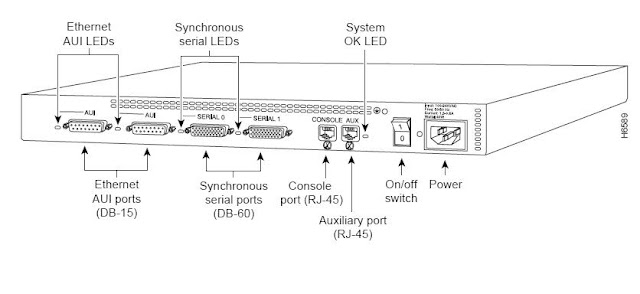Routers have both LAN and WAN interfaces, and whereas a router segments LANs , it is also used as the WAN access connection device. In this section, we will talk about the router's WAN interfaces and the WAN cabling.
Generally speaking, Cisco router have three kinds of interfaces:
- LAN Interfaces (Ethernet AUI, DB-9) -- Allow the router to connect to the LAN media through Ethernet or some other LAN technology such as Token Ring or ATM.
- Management ports (Console, Auxilary) -- Provide a text-based connection for the configuration and troubleshooting of the router.
- WAN Interfaces (Serial, ISDN BRI) -- Are made through a WAN interface on a router to service provider to distant site or to the internet.
The following picture shows a router with the most common router interfaces: Ethernet AUI port, Serial port, Console port and Auxiliary port.
 |
| route interfaces |
Some routers have additional ports such as DB-9 port for token ring network and ISDN Basic Rate Interface (BRI) port for low cost dial-on-demand WAN connection, as illustrated in the following picture.
 |
| DB-9 |
For long-distance communication, WANs use serial transmission. Serial transmission is a method of data transmission in which bits of data are transmitted sequenctially over a single channel. On the contrary, parallel data transmission transmits several bits at a time with parallel data transmission.
Serial ports on Cisco routers use 60-pin DB-60 connector or the smaller "smart-serial" connector for the purpose of WAN connections. Serial ports on the other end of the WAN connection is dependent on the service providers and the type of their DCE equipment. Some of the different signaling standards and connectors that might be found on DCE equipment include EIA/TIA-232, EIA/TIA-449, V.35, X.21, and EIA-530.
When you order the WAN connection cable, you receive a serial transition cable with a DB-60 connector (also called five-in-one serial connector) at one end and the connector appropriate for the standards you specify at the other end. Whereas the five-in-one connector connects to the DB-60 port on a serial WAN interface card (WIC) on the DTE (your router), the specified connector plugs into the specific WIC on the DCE (provider's Modem or CSU/DSU). What specific connector to use depends on whether we need EIA/TIA-232, EIA/TIA-449, V.35, X.21, or EIA-530.
 |
| router connections |
In some cases such as back-to-back connection, your router could act as DCE, instead of DTE. Thererfor, in addition to determining the cable type, you need to determine whether you need data terminal equipment (DTE) or data circuit-terminating equipment (DCE) connectors for your WAN equipment.
When a router directly connect to a data network such as a service provider WAN link, the router is referred to as Data Terminal Equipment, or DTE. We need to select DTE serial cable in this case.
 |
| DTE serial cable |
In some cases, if you are performing a back-to-back router scenario (Cisco documents) in a test environment, one of the routers is a DTE, and the other is a DCE. To implement this, you need a DTE cable for one router, and a DCE cable for another router. You might also be able to buy a special back-to-back cable, which is wired with a DTE side and DCE side.
 |
| back-to-back router connection |
clear and eazy,thanks
ReplyDeletenice blog CISCO Meraki Switches Firewall
ReplyDeleteGood read! Used routers and switches offer dependable performance for expanding networks.
ReplyDelete